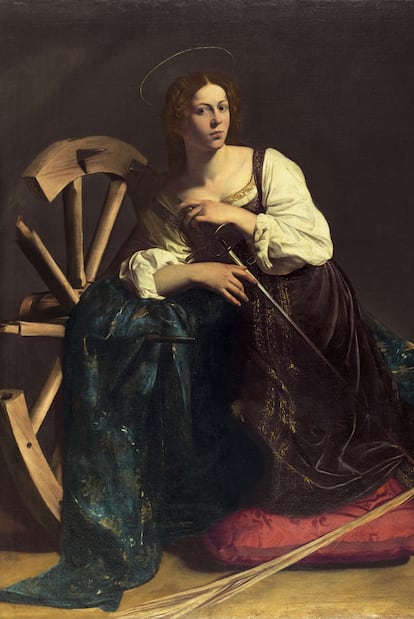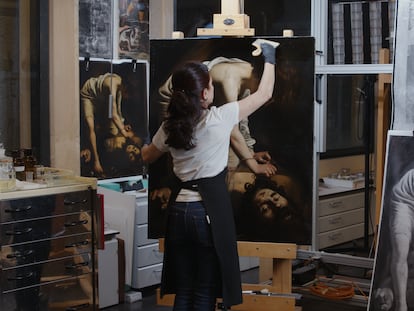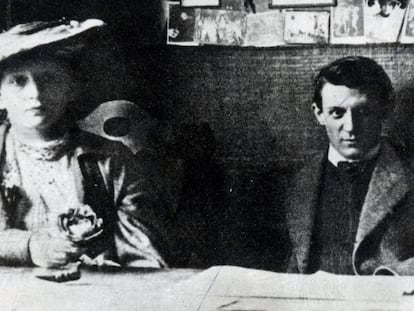Sex, violence, light, and shadow: The endless fascination with Caravaggio
The painter’s life ‘in extremis’ and the questions over his sexuality explain the public’s attraction to the Lombard genius


Why is Caravaggio (1571-1610) so fascinating? Last year, the French-Italian co-production Caravaggio’s Shadow, directed by Michele Placido, was released; in the coming months, Madrid’s Ecce Homo, a painting whose property is still in the hands of lawyers, should see the light of day; not without some controversy, The Capodimonte Museum in Naples lent some paintings by the Lombard to the Louvre this summer; the Salome with the Head of John the Baptist has finally found a definitive space in the new gallery of the Royal Collections of Madrid, and even Spain’s Prado Museum exhibits the restoration of David with the Head of Goliath. That work has its own “Caravaggesque” mystery. Nobody knows how it got to the Madrid art gallery.
What is it behind the Italian master’s canvases that generates so much interest? A tragic life, the revolution in painting, his sexuality, violence, or that he transformed prostitutes into virgins? “It’s a bit of all that. His work is timeless and touches the essence of being human, by using real models, and this resonates with the 21st century,” David García, head of Italian painting at the Prado Museum reflects. “Not forgetting his bisexuality or a somewhat premature death for the life expectancy of the 17th century.” This is the academic explanation. Walking the streets of Rome when the painter was alive was different. The Lombard was an extraordinary painter, only surpassed by the “divine” Michelangelo (with whom he would compare himself throughout his life). He was rejected and yet admired by the Church. And he was a murderer. During the 14 years (1592-1606) that he spent in Rome — until he killed the criminal Ranuccio Tomassoni in a duel — he faced countless bloody disputes. But, far from stereotypes, he was never a madman, but rather a 17th century man — where honor and courage surpassed painting — cornered by a violent society. Not even prostitutes eased the stress of existing.
“Liar, lazy, slut. I’m going to throw a fucking potty in your face! Let the executioner fuck you and put it up your ass!” These insults — preserved by the State Archives of Rome and recorded by the writer Andrew Graham-Dixon in his biography — are directed at a courtesan, by the artist, who in 1602 did not want to sleep with him. He was brought before a judge for assault. He disfigured the prostitute with a sfregio (slash). His “revenge” consisted of lacerating the face with a knife. In Naples, years later, Caravaggio suffered the same punishment, which he survived, once again, as one of the many miracles he illuminated on canvas throughout a tumultuous life of 39 years.
The time of studying under Simone Peterzano, Antiveduto Gramatica or Cavaliere d’Arpino from a tender age was long gone. He barely learned to mix colors. Caravaggio was self-taught and used a group of courtesan-models. Was he a pimp? Perhaps that would explain his erratic nightlife. He had two favorites: Fillide Melandroni (who had posed as Mary Magdalen in Ecstasy; in Judith Beheading Holofernes, and as Saint Catherine in the Thyssen collection in Madrid, and in Martha and Mary Magdalene) and Anna Bianchini (the short, redhead, who appears in Penitent Magdalene and Rest on the Flight into Egypt). Both were prostituted by their mothers.

The master painted from the darkness towards the light — an idea taken from various 16th century Lombard painters — and left the backgrounds black, with this he focused the action, and the mind, on a sequence, a kind of “still.” He put the viewer, free of distractions, into the “scene.” Without that added work he was also able to produce faster. He fitted together images and used black to hide the connecting spaces. Painting was isolating. He used incisions (traced with the handle of the brush) to locate where the models would be the next day. And he used to hang a light source from the ceiling in order to create the contrasts of his famous tenebrism. He also used mirrors. The result was so “real” that it was overwhelming.
But the birth of the legend is linked to the decoration of the Contarelli Chapel in San Luigi dei Francesi in Rome. It was his first public commission and a great responsibility for someone who was 29 years old. It had to go from 5-foot canvases to more than 10 feet wide and long. He finished the paintings on July 4, 1600, and they were an immediate success. He charged 400 scudi for representing two passages from the life of Saint Matthew (The Calling and The Martyrdom).
Between carnival and lent
It was the beginning of Caravaggism. Neither Ribera nor Rembrandt nor Georges de La Tour can be understood without his paintings, nor can the (current) interest in the painter’s sexuality. “Modern notions of sexual identification make no sense when applied to the 17th century, with its own interpretations of punishable social behavior,” says Keith Christiansen, an expert on Lombardy. “It is documented that he had some type of relationship with women. His intimacy with men remains pure speculation. He was never accused of sodomy.” Of course, he continued painting. But between 1603 and 1606 only three orders arrived. Caravaggio was restless. But, in a duel on May 28, 1606, he severed the femoral artery of a pimp called Tomassoni, who bled to death. A bando capitale (a bounty) was soon issued. Anyone in the Papal States could kill the painter and obtain the reward.
From then on, Caravaggio was on the run (with his model, and possibly his lover, Cecco), and only stopped when he died in Porto Ercole — 50 miles from the Italian capital — on July 18 or 19, 1610. His escape remains to be explained. He took refuge in the Alban mountains (near Rome), traveled to Naples (protected by Constanza Colonna and her son Fabrizio), when he was already considered the best painter in Italy. At the height of his fame he went to Malta (1607), where he left the impressive Beheading of Saint John the Baptist in his oratory, and managed to be ordained a knight of Masterful Obedience.
However, hostage to his character, he attacked Count Della Vezza, a knight of Justice. Although, again, he managed to escape, this time from a rock prison, perhaps with the help of the Colonna, to Syracuse (Sicily) in October 1608. The following year he was back in Naples and stayed at the Colonna Palace in Chiaia. He then had to paint the Ecce Homo that is now in Madrid. There, he had a premonition. He was attacked in the Osteria del Cerriglio, a kind of tavern and brothel, by Della Vezza and his entourage, and was left crippled. Without taking time to recover, he traveled to Rome on a felucca. With him, he took several paintings. The bando capitale had, at last, been revoked. But he fell ill and never arrived at his destination.
Centuries of oblivion passed. “Caravaggism had a general impact, although it only lasted one generation. When the historian Luigi Lanzi (1732-1810) studied the 17th century, the artist who seemed crucial to him was Annibale Carracci, not Caravaggio. And most contemporaries would have agreed,” Keith Christiansen explains. Meanwhile, the expert Bernard Berenson (1865-1959) argued that the fascination with the painter was a consequence more of his life than of his work. Did dying so young help create the myth? “For me, that information does not tell the story,” expert Nicola Spinosa says in disagreement. In Spain, he was considered a good painter, but “from afar.”
It was the historian Roberto Longhi (1890-1970) who recovered Caravaggio’s reputation as a great painter from the dusty window of looking through art and the past. In 1951 he organized the first exhibition on the genius at the Royal Palace of Milan. The black and white photos pose the question, “who is this Caravaggio?” Works that today would never leave the churches that house them. The lintels are saved thanks to the skill of workers (more like peasants), who did not even wear gloves and put their hands directly on the canvases. “Forgetting is logical. Tastes change over the centuries. Murillo does not reappear until the 19th century in France,” comments a historian, who requests anonymity. And he adds: “Longhi’s merit is understanding that he was one of the best and was poorly studied.” Furthermore, the themes of his painting are current: the dignity of the poor, injustice, and the redemption of man. A unique life between carnival and Lent, between the Church and the brothel. The construction of a contemporary legend of the 17th century.
Sign up for our weekly newsletter to get more English-language news coverage from EL PAÍS USA Edition
Tu suscripción se está usando en otro dispositivo
¿Quieres añadir otro usuario a tu suscripción?
Si continúas leyendo en este dispositivo, no se podrá leer en el otro.
FlechaTu suscripción se está usando en otro dispositivo y solo puedes acceder a EL PAÍS desde un dispositivo a la vez.
Si quieres compartir tu cuenta, cambia tu suscripción a la modalidad Premium, así podrás añadir otro usuario. Cada uno accederá con su propia cuenta de email, lo que os permitirá personalizar vuestra experiencia en EL PAÍS.
¿Tienes una suscripción de empresa? Accede aquí para contratar más cuentas.
En el caso de no saber quién está usando tu cuenta, te recomendamos cambiar tu contraseña aquí.
Si decides continuar compartiendo tu cuenta, este mensaje se mostrará en tu dispositivo y en el de la otra persona que está usando tu cuenta de forma indefinida, afectando a tu experiencia de lectura. Puedes consultar aquí los términos y condiciones de la suscripción digital.
More information
Archived In
Últimas noticias
Welcome to the post-religion era: The idea of Christianity as the absolute truth has become obsolete
‘I thought you would like it’: The risky sexual practice popularized by TV shows and TikTok
The digitalization of tourism: ‘They promise experiences and gave us the worst possible one’
Mexican peso defies uncertainty with forecasts of a new period of stability in 2026
Most viewed
- Sinaloa Cartel war is taking its toll on Los Chapitos
- Reinhard Genzel, Nobel laureate in physics: ‘One-minute videos will never give you the truth’
- Oona Chaplin: ‘I told James Cameron that I was living in a treehouse and starting a permaculture project with a friend’
- Why the price of coffee has skyrocketed: from Brazilian plantations to specialty coffee houses
- Silver prices are going crazy: This is what’s fueling the rally










































